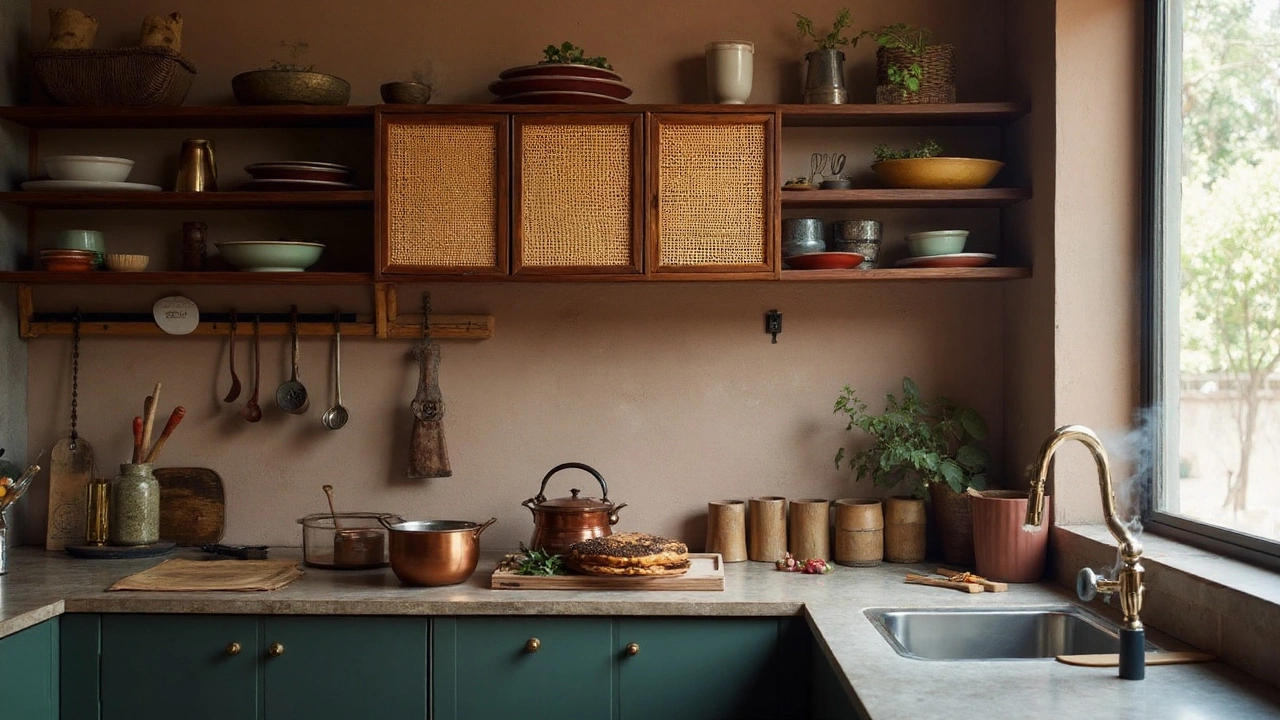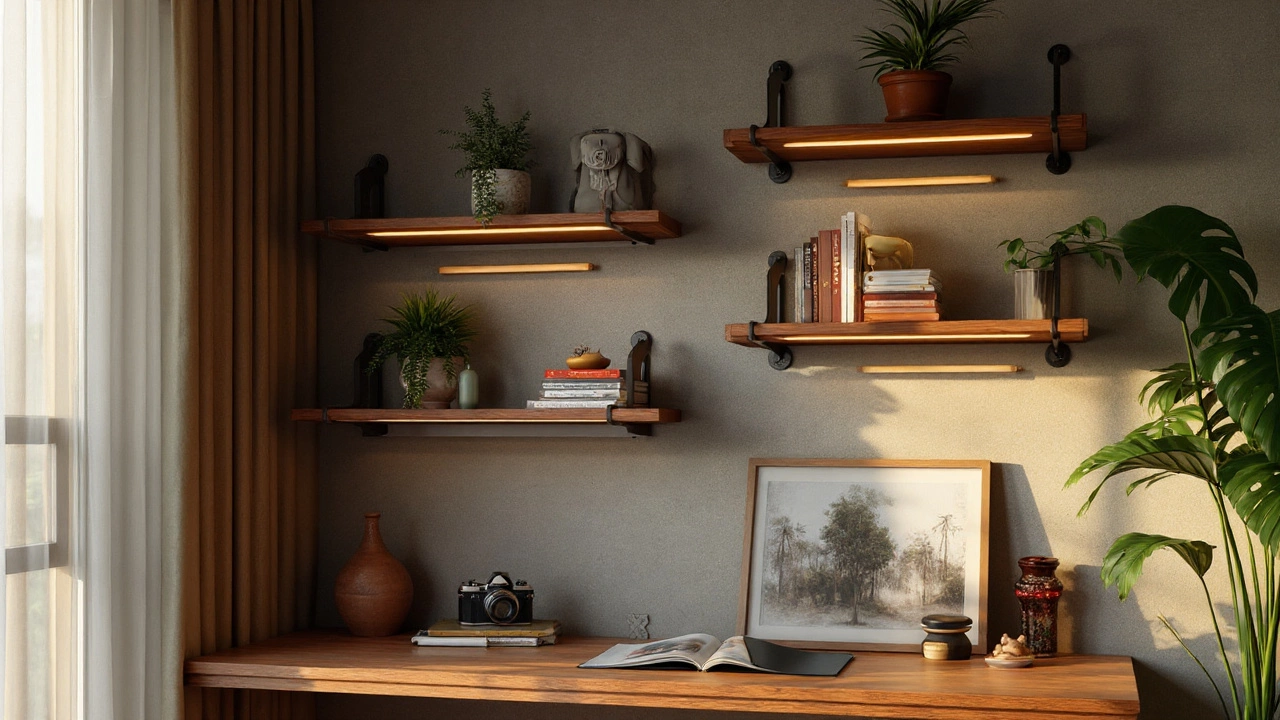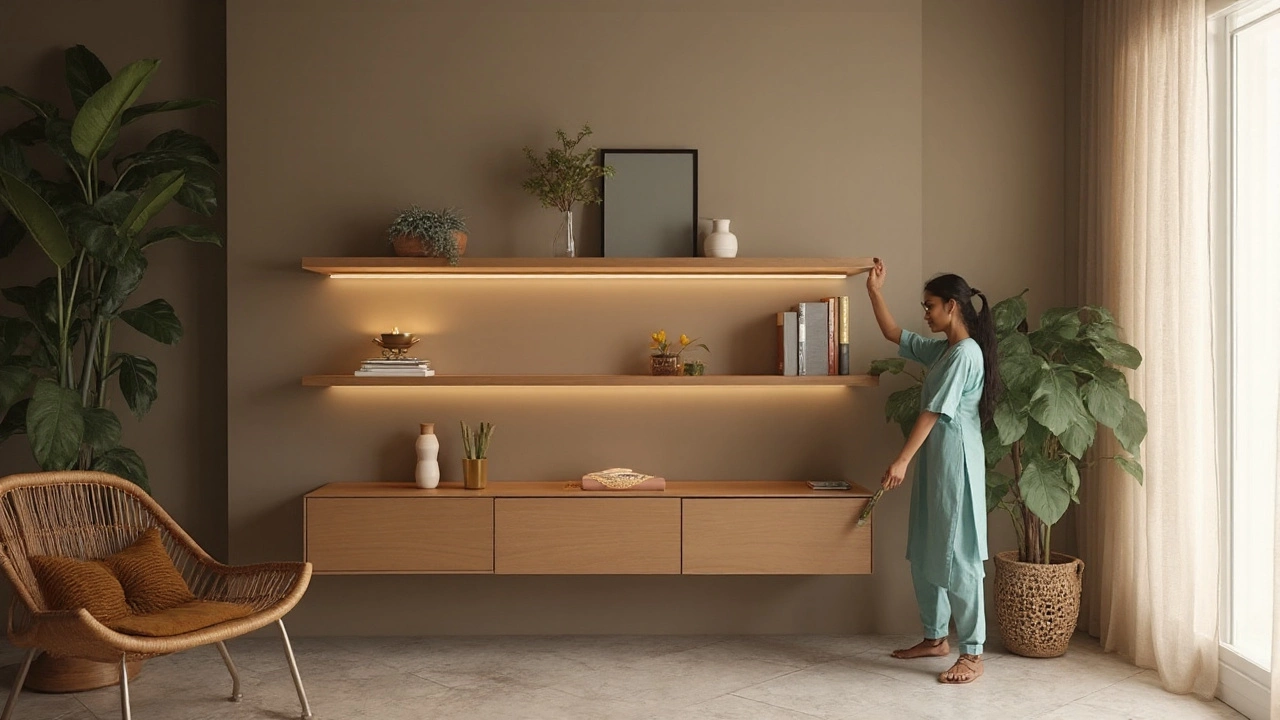Think floating shelves are “over”? Not if you use them well. In 2025, they sit in that sweet spot: timeless when proportioned and styled right, tired when they’re bulky, stark-white, and over-cluttered. If you’re debating whether yours look dated-or if you should add new ones-here’s a clear, practical answer with styling rules, measurements that actually work, and smarter alternatives when open storage isn’t the best fit.
TL;DR: Are Floating Shelves Dated in 2025?
- No, floating shelves aren’t dated. They’re a classic utility piece that can read modern or tired depending on thickness, finish, placement, and styling.
- They look current in warm wood, slim or properly engineered profiles, mixed materials (wood/metal), and with edited, purposeful displays.
- They feel dated when they’re glossy-white and chunky, crammed with random decor, or used wall-to-wall like a replacement for cabinets.
- Use them selectively: one to three spans, not every wall. Mix with closed storage to avoid dust and visual noise-especially in kitchens.
- If you hate upkeep, consider alternatives: rail-and-shelf systems, shallow picture ledges, slim framed brackets, or built-ins with a reveal.
How to Decide if Floating Shelves Fit Your Space
Start with your needs, not the trend. The quickest way to make shelves feel dated is forcing them into a room that wants something else. Use this simple decision tree.
Decision tree (fast):
- If you need heavy-duty storage (many books, dinnerware): choose floating shelves only if you can hit studs or solid masonry and keep spans under 90-100 cm (36-40 in). Otherwise, use visible brackets or a rail system.
- If you dislike dusting or have a greasy kitchen zone (near a hob): limit open runs to 1-2 short spans away from splatter, or go for glass-front cabinets.
- If your room feels busy already: add just one shelf or a slim picture ledge and keep it 50% empty for negative space.
- If your walls are plasterboard with unknown studs (very UK): confirm stud locations first. No studs? Use heavyweight cavity anchors rated for your load or switch to bracketed shelves that spread the load.
- If you rent: use fewer, shorter shelves with minimal holes, or lean on freestanding étagères and picture ledges.
Why the caution? The National Kitchen & Bath Association’s 2024 Design Trends Report notes homeowners still like some open shelving for display, but prefer a mix with closed storage to ease cleaning. Houzz UK’s 2025 insights echo this: open runs are used as accents-not as full replacements for wall units-especially in smaller British kitchens.
Wall type matters. British Gypsum’s fixing guidance (2023) shows a wide spread in plasterboard anchor performance. Unrated plugs can rip out under shear loads; good cavity anchors or hitting studs change the game. IKEA’s product sheets (2025) also vary load ratings by wall type-so always check the load per bracket, per shelf, and per wall material.
Good fit signals: you want lighter visual weight, have a few worthy objects to display, and you’re willing to maintain them. If that’s you, shelves won’t look dated-they’ll look deliberate.

Styling Steps: Make Floating Shelves Look Fresh, Not Fussy
Here’s a step-by-step styling playbook that keeps shelves current in 2025’s warm-minimal vibe-think tactile materials, softer silhouettes, and “bookshelf wealth” (curated, lived-in, not sparse).
- Edit first. Pull everything off. Keep only items you love or use weekly. Aim for 60% display, 40% breathing room.
- Pick a palette. Two base neutrals + one accent tone + one metal is enough. Repeating materials (oak + linen + matte black) feels cohesive.
- Vary height and mass. Mix a few taller pieces (vase, framed art) with mid-height stacks (books, bowls) and low anchors (boxes). Avoid a row of same-height objects-it reads flat.
- Use the triangle rule. Build a loose visual triangle on each shelf: heavier item at one corner, a medium in the middle, a lighter piece opposite. Then zoom out and create a larger triangle across the whole set of shelves.
- Stack with intent. Lay books horizontally to create plinths and top with a small object. Stand a few vertically, but only with neutral bookends.
- Lean art. One framed piece per span, leaning-not hung-behind objects adds depth. Keep frames slim or gently rounded; shiny thick frames feel dated.
- Repeat textures. Two or three repeats of the same texture (stone, rattan, linen, matte ceramic) tie the whole story together.
- Mind negative space. Leave at least one open gap the width of a paperback on every 60 cm (24 in) of shelf. The eye needs rest.
- Light it. Micro-LED pucks or a hidden strip under the shelf lip warms everything. 2700-3000K works for most UK rooms in the evening.
- Seasonal swap. Keep a “rotation box.” Swap two items each season-branch clippings, a small artwork, or a bowl-so shelves feel alive, not stagnant.
Thickness and profile: Ultra-chunky in glossy white screams 2010s showroom. In 2025, slimmer or honestly chunky in real timber feels right: 25-30 mm (1-1¼ in) for most spans; up to 38 mm (1½ in) if you need structure or like a hefty look. Concealed steel brackets should match the load; don’t fake thickness with hollow skins unless the bracket is specified for the job.
Finishes that age well: oiled oak, walnut, ash, clay-painted MDF edges properly sealed, or powder-coated steel. Overly shiny laminates can date fast; the “quiet luxury” trend leans matte and tactile.
Where to place: odd numbers look intentional: a single long span or a stack of two or three. Symmetry works over a sideboard; asymmetry suits alcoves. Keep runs broken up-full wall-length open shelves can feel like budget cabinetry.
Real-World Examples, Layout Formulas, and Decision Cheats
I live in a small Oxford terrace, so I get the storage vs style fight. These setups work in tight UK rooms without looking faddy.
Kitchen (small, busy household)
- Two 80 cm oak shelves on the non-hob side. Bottom shelf at 46-50 cm above the worktop, second shelf another 30-35 cm above.
- On the lower shelf: daily mugs, a lidded jar for tea, and one plant. Upper shelf: a short stack of cookbooks, a bowl, and one art piece leaning.
- Grease reality: keep shelves 60 cm minimum from the hob edge. Wipe weekly; use closed storage for oils and spices.
Living room alcove (typical Victorian terrace)
- Two or three spans in the chimney-breast alcove. Leave 20-25 cm between shelves for books plus objects.
- Thickness 25-30 mm to avoid sag; add hidden steel brackets fixed into brick, not just plaster.
- Style with 60% books, 30% objects, 10% negative space. Add a small, warm downlight under the bottom shelf.
Hallway or entry
- One slim shelf (12-18 cm deep) at 105-110 cm high as a landing strip for keys and post.
- Pair with a small round mirror above. Keep depth shallow so it doesn’t clip shoulders in a narrow corridor.
Bathroom
- Keep at least 30 cm above the cistern lid. Use moisture-resistant finishes (oiled hardwood, sealed veneer, or powder-coated metal).
- Store decanted essentials only; hide backups in a vanity to avoid the chemist’s-shelf look.
Home office
- One long shelf above a desk, 45-50 cm above the desktop for head clearance.
- Use magazine files and one lidded box to hide paper mess; leave one clean zone directly above your monitor to reduce visual stress.
Layout and sizing formulas (quick math)
- Shelf height above sofa: lowest shelf 15-25 cm above the back cushion or 140-150 cm from floor to shelf top.
- Between two shelves: 28-35 cm works for most objects and books; go 38-40 cm if you display taller vases.
- Depth: 20-25 cm for books; 12-18 cm for corridors; 20-22 cm for kitchens (mugs/plates).
- Span: keep heavy-load spans under 90-100 cm unless you have a rated bracket system. Shorter spans sag less and feel more bespoke.
- Rule of thirds: divide the wall width visually into thirds and place the shelf run in one or two thirds, not end-to-end.
When to choose alternatives
If you’re fighting dust, need more load, or want a new look, these swaps feel very 2025.
| Option | Best for | Can feel dated when | Quick fix |
|---|---|---|---|
| Floating shelves | Light display, warm minimal rooms | Glossy white, too thick, overfilled | Switch to timber, edit display, add lighting |
| Visible brackets (slim metal) | Heavier loads, honest structure | Chunky corbels, ornate scrolls | Use thin black/bronze brackets, keep lines clean |
| Picture ledges | Art rotation, narrow spaces | Overlapping frames only, no depth variety | Mix books and a low bowl, add one plant |
| Rail-and-shelf systems | Adjustability, renters, growing book collections | Cheap white rails with sagging boards | Upgrade to wood shelves, darker rails |
| Built-ins with a reveal | Polished living rooms, alcoves | All open, wall-to-wall without respite | Add doors to lower third, vary shelf heights |
Trend note: Pinterest’s 2025 “Bookshelf Wealth” momentum and Houzz UK photos show fewer, better objects and warmer materials. It isn’t about showing everything-it’s about curation.

Quick Checklist, Pitfalls, and Mini‑FAQ
Fast checklist (before you buy or style)
- Wall check: plasterboard vs masonry? Find studs or choose rated anchors.
- Load check: what are you storing? Books and plates are heavy; glass and plants add hidden weight (water!).
- Span and thickness: keep heavy spans under 90-100 cm; 25-30 mm thickness suits most needs.
- Finish choice: warm wood or matte paint beats glossy white for a current look.
- Mix storage: pair open shelves with hidden storage to cut dust and clutter.
- Styling plan: 60/30/10 rule-functional, decorative, negative space.
- Maintenance: can you wipe weekly? If not, reduce open storage.
Common pitfalls (and easy fixes)
- Pitfall: Chunky, shiny white boards that scream showroom. Fix: swap to oiled oak or painted MDF in a matte finish; reduce thickness or add an honest slim metal bracket.
- Pitfall: Sagging over time. Fix: shorten span, use stronger brackets, or add a front hardwood lipping; always anchor into studs or masonry where possible.
- Pitfall: Grease and dust in kitchens. Fix: keep shelves away from the hob, store only wipeable items, and run the extractor fan.
- Pitfall: Visual clutter. Fix: remove 30% of objects, repeat 2-3 materials, and leave planned gaps.
- Pitfall: Flat styling. Fix: add one leaning art piece per span and vary heights; introduce a plant for life.
Mini‑FAQ
- Are floating shelves dated? No. Done right, they read classic and current. What dates them is bulky white boards, clutter, and wall-to-wall runs.
- Are floating shelves out in kitchens? Not out, just more selective. NKBA (2024) and Houzz UK (2025) show mixed storage trending: a couple of open shelves away from the hob, with most items behind doors.
- How thick should they be? 25-30 mm covers most domestic spans. Go thicker only if your bracket demands it or you like the look; keep the finish matte or oiled.
- What depth works best? 20-25 cm for books/dinnerware; 12-18 cm for hallways; 20-22 cm in kitchens for mugs and bowls.
- How high above a loo? At least 30 cm above the cistern lid, more if you’ll lift the lid for maintenance.
- Do black shelves date? Matte black metal or wood still looks sharp in 2025 if the room has other black accents (frames, handles). The key is repetition and balance.
- Glass shelves-dated or chic? Chic in baths when minimal and well-lit; dated when paired with ornate brackets. Keep profiles slim and hardware simple.
- Can plasterboard hold them? Yes-with the right anchors and loads. British Gypsum’s guidance supports rated cavity fixings, but heavy loads should hit studs or masonry.
Pro tips (evidence-backed)
- Lighting increases perceived quality. Aim for 150-300 lux on the shelf face; 2700-3000K LEDs suit evening rooms.
- Repeat a material three times. The eye reads it as intentional design, a staple trick in editorial styling.
- Keep 50% negative space across the whole set. Houzz photos with higher save rates often show clear breathing room between objects.
Next steps
- Audit your wall type and intended load; jot down spans, depth, thickness, and bracket type.
- Choose a finish that echoes something else in the room (floor, table, handles) for instant cohesion.
- Mock up with painter’s tape on the wall to test height and spacing for a week before drilling.
Troubleshooting
- The shelf looks small on a big wall. Add a second shelf 28-35 cm above/below, or extend the span by 10-20 cm (while staying within load limits).
- Everything still feels messy. Box and label utility items; leave display pieces only. If that fails, switch the lower shelf to a shallow cabinet.
- Bracket shadows show. Add an LED strip under the front lip or repaint the wall a shade deeper to hide faint irregularities.
Final thought: treat floating shelves as accents, not a storage cure-all. When they support how you actually live-and when they’re edited-they don’t date. They just quietly do their job and look good doing it.
